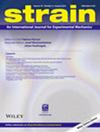Extracting true stresses and strains from nominal stresses and strains in tensile testing
IF 2.4
3区 材料科学
Q2 MATERIALS SCIENCE, CHARACTERIZATION & TESTING
引用次数: 7
Abstract
Seemingly a simple task, the extraction of the flow curve (true stress vs. true plastic strain) from nominal stresses and strains in standard tensile testing still has its unsolved points. This study addresses two of them: (i) in materials without yield point phenomenon (or generally in the region of homogeneous plastic deformation), the true stress is typically calculated assuming constant volume, ignoring the elastic volume changes. Here, we derive a set of exact analytical solutions for true stresses and strains with remarkable simplicity and beauty that fully account for the elastic volume changes. This set of exact solutions is cross‐checked by finite element simulations as well as zeroth‐ and first‐order approximations; perfect agreement has been found. (ii) In materials with a pronounced yield point phenomenon, a complicated three‐dimensional stress state inevitably arises at the edge of the Lüders bands, which masks the real (or inherent) material behaviour. To determine the real material behaviour in the Lüders region, here we use a new macroscopic analytical approach characterised by a high true upper yield point, a typical strain hardening behaviour common for many materials, and the triaxiality of the stress state that inevitably develops at the edges of the Lüders bands and that determines the stress level at the observed lower yield point. This approach is verified by experiments (including video observations as well as digital image correlation (DIC) strain distribution measurements) and finite element simulations with very good agreement.从拉伸试验中的标称应力和应变中提取真实应力和应力
从标准拉伸试验的名义应力和应变中提取流动曲线(真应力与真塑性应变)似乎是一项简单的任务,但仍有其未解决的问题。本研究解决了其中两个问题:(i)在没有屈服点现象的材料(或一般在均匀塑性变形区域)中,通常采用恒体积计算真实应力,忽略弹性体积变化。在这里,我们导出了一组精确的解析解,以非常简单和美观,充分说明了弹性体积的变化。这组精确解是由有限元模拟以及零阶和一阶近似交叉检查的;完全一致。(ii)在具有明显屈服点现象的材料中,复杂的三维应力状态不可避免地出现在l德斯带的边缘,这掩盖了真实的(或固有的)材料行为。为了确定材料在l ders区域的真实行为,我们使用了一种新的宏观分析方法,其特征是高的真实上限屈服点,许多材料常见的典型应变硬化行为,以及在l ders带边缘不可避免地发展的应力状态的三轴性,并决定了观察到的较低屈服点的应力水平。实验(包括视频观测和数字图像相关(DIC)应变分布测量)和有限元模拟验证了该方法的正确性。
本文章由计算机程序翻译,如有差异,请以英文原文为准。
求助全文
约1分钟内获得全文
求助全文
来源期刊

Strain
工程技术-材料科学:表征与测试
CiteScore
4.10
自引率
4.80%
发文量
27
期刊介绍:
Strain is an international journal that contains contributions from leading-edge research on the measurement of the mechanical behaviour of structures and systems. Strain only accepts contributions with sufficient novelty in the design, implementation, and/or validation of experimental methodologies to characterize materials, structures, and systems; i.e. contributions that are limited to the application of established methodologies are outside of the scope of the journal. The journal includes papers from all engineering disciplines that deal with material behaviour and degradation under load, structural design and measurement techniques. Although the thrust of the journal is experimental, numerical simulations and validation are included in the coverage.
Strain welcomes papers that deal with novel work in the following areas:
experimental techniques
non-destructive evaluation techniques
numerical analysis, simulation and validation
residual stress measurement techniques
design of composite structures and components
impact behaviour of materials and structures
signal and image processing
transducer and sensor design
structural health monitoring
biomechanics
extreme environment
micro- and nano-scale testing method.
 求助内容:
求助内容: 应助结果提醒方式:
应助结果提醒方式:


